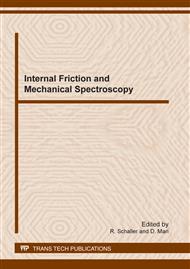p.116
p.122
p.131
p.137
p.143
p.149
p.155
p.161
p.167
Influence of Strain Hardening 1% by Torsion on the Behavior of a Single Crystal Alloy (Cu–at.9% Al) in Internal Friction at High Temperature
Abstract:
The purpose of this study is to highlight the influence of the strain hardening on internal friction behaviour of a copper single crystal alloy Cu-Al (9% at.) using Isothermal Mechanical Spectroscopy (IMS) technique. To do this, the sample was cold worked about 1% by torsion and tested at different stabilized levels of temperatures. Thus the specimen have been progressively heated to 1179 K and then cooled down to room temperature. The advantage of IMS experiments is to allow to compare the isothermal internal friction spectra obtained during heating (in this case, the annealing temperature (TA) is equal to the temperature of measurement (TM) with the measurements performed at various temperatures during cooling after annealing at 1179 K (TM < TA in this case). The results obtained in increasing temperature step by step (TA = TM) show the existence of two (02) independent relaxation peaks from 914 K to 1179 K. The first one, called here P1 (at about 0.7 TMelt at 1Hz), decreased with increasing the annealing temperature, while a new relaxation peak P2 (at about 0.9 TMelt at 1Hz) progressively developed. However for high temperature annealing, IMS tests (TA > TM) does reveal only one peak P2. It appears, therefore, clearly that the strain hardening is responsible for the P1 existence. To monitor the evolution of P1 and P2 with the temperature, a method of peaks decomposition already published was applied. The relaxation parameters, deduced from the Arrhenius plots, were thus accurately determined. The mechanism responsible of the P1 and P2 peaks appearance has been attributed to the movement of dislocation segments inside the sample microstructure.
Info:
Periodical:
Pages:
143-148
Citation:
Online since:
January 2012
Authors:
Price:
Сopyright:
© 2012 Trans Tech Publications Ltd. All Rights Reserved
Share:
Citation:


